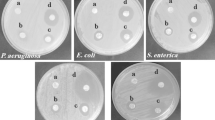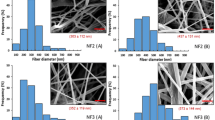Abstract
The purpose of the present research was to prepare an active electrospun nanofiber mat based on the blend of kafirin (Kaf) and polylactic acid (PLA) with clove essential oil (CEO) and to investigate its properties for the development of an antimicrobial nanofilm. For this purpose, ultrafine Kaf/PLA nanofibers with different proportions of Kaf/PLA (15:85%, 20:80%, 25:75%, and 50:50% (v/v)) were prepared using an electrospinning device at a voltage of 25–28 kV, a distance between the needle tip and the collector of 14 cm, and a flow rate of 1 ml/h and examined for their morphology. Then, the CEO was incorporated into the optimized Kaf/PLA nanofibers at different concentrations (3, 6, and 9% (v/v)). Scanning electron microscopy (SEM), Fourier transform infrared spectroscopy (FTIR), and thermogravimetric analysis (TGA) were used to investigate the properties of the nanofibers produced. The antimicrobial activity was also investigated. The results of the SEM examination showed that the produced ultrafine fibers had a uniform morphology with a cylindrical shape without beads, regardless of the amount of CEO. The FTIR test confirmed the formation of new chemical interactions between Kaf, PLA, and the CEO. According to the TGA results, the incorporated CEO increased the thermal stability of the nanofibers. The antimicrobial activity of CEO was confirmed by analyzing the minimum inhibitory concentration and minimum bactericidal concentration against Listeria monocytogenes, Pseudomonas aeruginosa, Staphylococcus aureus, and Escherichia coli. The investigation of the antimicrobial activity of nanofibers also showed that nanofibers containing CEO have a good inhibitory effect against both Gram-positive and Gram-negative bacteria. The nanofibers produced with 9% (v/v) CEO were the most effective against all microorganisms tested. Finally, the release behavior of Kaf/PLA nanofibers loaded with CEO was investigated at three different temperatures (4, 25, and 37 °C) and two food simulants (50% and 95% ethanol). The release results showed that the release mechanism was consistent with Fick’s model. The results showed that at all three temperatures, the release rate is higher in 98% ethanol than in 50% ethanol. The present study showed that active nanofibers containing CEO have high potential for use in the food packaging industry to reduce microbial contamination. Generally, this research proposed hopeful usage of CEO-loaded electrospun Kaf/PLA nanofibers for antimicrobial bioactive food packaging.






Similar content being viewed by others
Data availability
Data will be available upon request.
References
Mihindukulasuriya S, Lim L-T (2014) Nanotechnology development in food packaging: a review. Trends Food Sci Technol 40(2):149–167
Chen H et al (2019) Development of active packaging film containing bioactive components encapsulated in β-cyclodextrin and its application. Food Hydrocoll 90:360–366
Amiri S et al (2021) Natural protective agents and their applications as bio-preservatives in the food industry: an overview of current and future applications. Ital J Food Sci 33(SP1):55–68
Ejaz M et al (2018) Zinc oxide nanorods/clove essential oil incorporated Type B gelatin composite films and its applicability for shrimp packaging. Food Packag Shelf Life 15:113–121
Dashipour A et al (2014) Physical, antioxidant and antimicrobial characteristics of carboxymethyl cellulose edible film cooperated with clove essential oil. Zahedan J Res Med Sci 16(8)
Muppalla SR et al (2014) Carboxymethyl cellulose–polyvinyl alcohol films with clove oil for active packaging of ground chicken meat. Food Packag Shelf Life 2(2):51–58
Chen C et al (2018) Properties, vapour-phase antimicrobial and antioxidant activities of active poly (vinyl alcohol) packaging films incorporated with clove oil. Food Control 88:105–112
Yu D et al (2021) Fabrication, characterization, and antibacterial properties of citric acid crosslinked PVA electrospun microfibre mats for active food packaging. Packag Technol Sci 34(6):361–370
Devecioglu D, Turker M, Karbancioglu-Guler F (2022) Antifungal activities of different essential oils and their electrospun nanofibers against Aspergillus and Penicillium species isolated from bread. ACS Omega 7(42):37943–37953
Figueroa-Lopez KJ et al (2020) Development of electrospun active films of poly (3-hydroxybutyrate-co-3-hydroxyvalerate) by the incorporation of cyclodextrin inclusion complexes containing oregano essential oil. Food Hydrocoll 108:106013
Ataei S et al (2020) Essential oils-loaded electrospun biopolymers: a future perspective for active food packaging. Adv Polym Technol 2020:1–21
Wen P et al (2016) Encapsulation of cinnamon essential oil in electrospun nanofibrous film for active food packaging. Food Control 59:366–376
Xiao J (2016) Kafirin protein and its applications in nanoencapsulation, pickering emulsion and electrospun fiber. Rutgers University-Graduate School-New Brunswick
Xiao J et al (2016) Kafirin protein based electrospun fibers with tunable mechanical property, wettability, and release profile. J Agric Food Chem 64(16):3226–3233
Dror Y et al (2008) Nanofibers made of globular proteins. Biomacromol 9(10):2749–2754
Ameer Ali M, Shanavas A (2019) Polylactic acid-based nanocomposites: an important class of biodegradable composites. Green biopolymers and their nanocomposites. Springer, Singapore, pp 221–231
Min T et al (2021) Novel antimicrobial packaging film based on porous poly (lactic acid) nanofiber and polymeric coating for humidity-controlled release of thyme essential oil. LWT 135:110034
Taylor J et al (2005) Identification of kafirin film casting solvents. Food Chem 90(3):401–408
Pienaar SW (2015) Optimisation of kafirin extraction parameter for commercial applications. University of Pretoria
Uddin MA et al (2017) Study of chemical composition and medicinal properties of volatile oil from clove buds (Eugenia caryophyllus). Int J Pharm Sci Res 8(2):895
Cui H, Zhao C, Lin L (2015) The specific antibacterial activity of liposome-encapsulated Clove oil and its application in tofu. Food Control 56:128–134
Wikler MA (2006) Methods for dilution antimicrobial susceptibility tests for bacteria that grow aerobically: approved standard. Clsi (Nccls) 26:M7-A7
Amiri S et al (2022) Characterization of antimicrobial peptides produced by Lactobacillus acidophilus LA-5 and Bifidobacterium lactis BB-12 and their inhibitory effect against foodborne pathogens. LWT 153:112449
Chen Y et al (2020) Electrospun thymol-loaded porous cellulose acetate fibers with potential biomedical applications. Mater Sci Eng C 109:110536
Moon S-E, Kim H-Y, Cha J-D (2011) Synergistic effect between clove oil and its major compounds and antibiotics against oral bacteria. Arch Oral Biol 56(9):907–916
Diao W-R et al (2014) Chemical composition, antibacterial activity and mechanism of action of essential oil from seeds of fennel (Foeniculum vulgare Mill.). Food Control 35(1):109–116
Adel AM et al (2019) Inclusion complex of clove oil with chitosan/β-cyclodextrin citrate/oxidized nanocellulose biocomposite for active food packaging. Food Packag Shelf Life 20:100307
Nayak R et al (2013) Effect of viscosity and electrical conductivity on the morphology and fiber diameter in melt electrospinning of polypropylene. Text Res J 83(6):606–617
Aytac Z et al (2017) Antibacterial electrospun zein nanofibrous web encapsulating thymol/cyclodextrin-inclusion complex for food packaging. Food Chem 233:117–124
da Silva FT et al (2018) Action of ginger essential oil (Zingiber officinale) encapsulated in proteins ultrafine fibers on the antimicrobial control in situ. Int J Biol Macromol 118:107–115
Ardekani NT et al (2019) Evaluation of electrospun poly (vinyl alcohol)-based nanofiber mats incorporated with Zataria multiflora essential oil as potential wound dressing. Int J Biol Macromol 125:743–750
Teilaghi S, Movaffagh J, Bayat Z (2020) Preparation as well as evaluation of the nanofiber membrane loaded with Nigella sativa extract using the electrospinning method. J Polym Environ 28(6):1614–1625
Deng L et al (2019) Encapsulation of allopurinol by glucose cross-linked gelatin/zein nanofibers: characterization and release behavior. Food Hydrocoll 94:574–584
Cosme JG et al (2016) Development of biobased poly (lactic acid)/epoxidized natural rubber blends processed by electrospinning: morphological, structural and thermal properties. Mater Sci Appl 7(4):210–219
Lou D et al (2021) Preparation and characterization of kafirin-quercetin film for packaging cod during cold storage. J Texture Stud 52(1):71–80
Bai X et al (2019) Development and characterization of soybean oil microcapsules employing kafirin and sodium caseinate as wall materials. LWT 111:235–241
Wang W et al (2018) Fabrication and characterization of multilayered kafirin/gelatin film with one-way water barrier property. Food Hydrocoll 81:159–168
Hasheminejad N, Khodaiyan F, Safari M (2019) Improving the antifungal activity of clove essential oil encapsulated by chitosan nanoparticles. Food Chem 275:113–122
Devi KP et al (2010) Eugenol (an essential oil of clove) acts as an antibacterial agent against Salmonella typhi by disrupting the cellular membrane. J Ethnopharmacol 130(1):107–115
Shen Y et al (2021) Preparation and characterization of clove essential oil loaded nanoemulsion and pickering emulsion activated pullulan-gelatin based edible film. Int J Biol Macromol 181:528–539
Kashiri M et al (2017) Zein films and coatings as carriers and release systems of Zataria multiflora Boiss. essential oil for antimicrobial food packaging. Food Hydrocoll 70:260–268
Lamarra J et al (2020) Electrospun nanofibers of poly (vinyl alcohol) and chitosan-based emulsions functionalized with cabreuva essential oil. Int J Biol Macromol 160:307–318
Lin L et al (2019) Antibacterial properties of nanofibers containing chrysanthemum essential oil and their application as beef packaging. Int J Food Microbiol 292:21–30
Pinheiro Bruni G et al (2020) Electrospun protein fibers loaded with yerba mate extract for bioactive release in food packaging. J Sci Food Agric 100(8):3341–3350
Acknowledgements
The authors would like to extend their thanks to support of Urmia university and Drug Applied Research Center of Tabriz University of Medical Sciences is acknowledged.
Funding
The authors thank Urmia University for financial support.
Author information
Authors and Affiliations
Contributions
MJO and MAK involved in conceptualization, methodology, software. MJO, MAK, and SA took part in data curation, writing—original draft preparation. MJO involved in investigation. MAK took part in supervision. MJO and MAK involved in software, validation. MJO, MAK, HA, HH, and SA took part in writing— reviewing and editing.
Corresponding author
Ethics declarations
Conflict of interest
The authors declare that they have no conflicts of interest.
Ethics approval and consent to participate
Not applicable.
Consent for publication
The authors give their consent for this manuscript to be published in Cellulose journal.
Additional information
Publisher's Note
Springer Nature remains neutral with regard to jurisdictional claims in published maps and institutional affiliations.
Rights and permissions
Springer Nature or its licensor (e.g. a society or other partner) holds exclusive rights to this article under a publishing agreement with the author(s) or other rightsholder(s); author self-archiving of the accepted manuscript version of this article is solely governed by the terms of such publishing agreement and applicable law.
About this article
Cite this article
Jahanbakhsh Oskouei, M., Alizadeh Khaledabad, M., Almasi, H. et al. Preparation and characterization of kafirin/PLA electrospun nanofibers activated by Syzygium aromaticum essential oil. Polym. Bull. 81, 10061–10079 (2024). https://doi.org/10.1007/s00289-024-05179-z
Received:
Revised:
Accepted:
Published:
Issue Date:
DOI: https://doi.org/10.1007/s00289-024-05179-z




